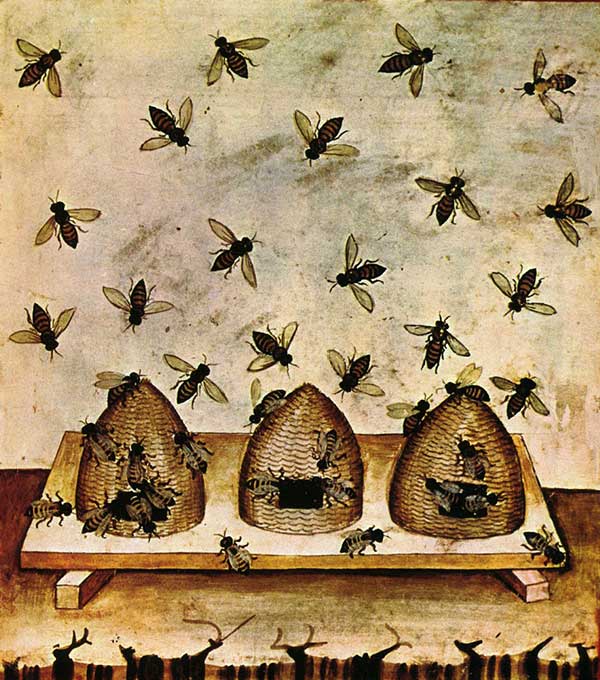Subtotal: $
Checkout
Poring on Cæsar’s death with earnest eye,
I heard a fretful buzzing in the pane:
‘Poor bee!’ I cried, ‘I’ll help thee by-and-by’;
Then dropp’d mine eyes upon the page again.
Alas! I did not rise; I help’d him not:
In the great voice of Roman history
I lost the pleading of the window-bee,
And all his woes and troubles were forgot.
In pity for the mighty chief, who bled
Beside his rival’s statue, I delay’d
To serve the little insect’s present need;
And so he died for lack of human aid.
I could not change the Roman’s destiny;
I might have set the honey-maker free.
—Charles Tennyson Turner, “Julius Cæsar and the Honey-Bee”
Charles Tennyson Turner’s bitterly tragicomic lament over the unnecessary demise of a house-trapped honeybee has long been one of my favorite poems. The poet, a clergyman and the elder brother of Alfred Lord Tennyson, led an appropriately elegiac life. He battled an opium addiction for years, his wife suffered from serious mental illness, and he was often unable to exercise his priestly functions due to his illnesses. His sonnets, which exhibit a combination of classical erudition and a deep tenderness towards the natural world, come close to suggesting the Platonic ideal of the English country parson.
The needless death of bees is a background leitmotif to the twenty-first-century concern for the current ecological crisis. Peruse back issues of the Guardian and one discovers a steady stream of articles and op-eds on the need to protect contemporary honey-makers from pesticides, on small successes in urban beekeeping, on the threats posed by gargantuan Asian “murder hornets” to vulnerable hives. Bees provide a convenient lens through which to read the wider portents of the Anthropocene.

An illustration of apiaries from the Tacuinum Sanitatis, fourteenth century
We humans have long looked to bees to show us how things are. A connection between bees and augury has existed since the ancient Greeks. Pausanias reports that locals claimed the temple of Apollo at Delphi was built by bees. Pindar refers to the oracle herself as the “Delphic bee.” The Homeric Hymn to Hermes, much concerned with prophecy and portent, describes a trio of winged goddesses whose revelations remain reliable as long as they keep to a diet of honey and honeycomb. Scripture, too, hints at links between the divine and the apoidean. The prophet Ezekiel eats a honey-sweet scroll covered front and back with divinely given words (Ezek. 3:3). Deborah (“bee” in Hebrew, like the Greek “Melissa”) is identified as a prophetess in Judges 4:4. In Judges 14, Samson retrieves honey from the corpse of a lion he kills, which furnishes the lapidary riddle: “Out of the eater came forth meat, and out of the strong came forth sweetness.”
British readers with a sweet tooth will recall the latter half of that phrase, complete with image of slain lion and swarming bees, as the distinctively Victorian motto emblazoned upon tins of Lyle’s Golden Syrup. The Guinness Book of World Records recognizes their label as the oldest continuously used branding on the planet. The longevity of honey itself is almost proverbial – one hears of archaeologists finding millennia-old pots containing edible (one wonders how they are sure) samples of the stuff.
If honey may last almost forever, Charles Tennyson Turner reminds us that bees themselves do not. One might argue that our modern apian auguries call for us to return to more organic agricultural methods. Faced with multiple ecological crises, we might reflect on the foolishness of “I’ll help thee by-and-by.”
Those with a view to more cultural kinds of conservation may recognize a common didactic image in past and present appeals to cultivate an organic literary culture.
So our student will flit like a busy bee through the entire garden of literature, will light on every blossom, collect a little nectar from each, and carry it to his hive. Since there is such an abundance of material that one cannot gather everything, he will at least take the most striking and fit this into his scheme of work. (Erasmus, De Copia)
Erasmus, that inveterate thief, who so shamelessly practices what he here preaches, draws both the commonplace simile and its attendant moral from Seneca’s Ad Lucilium 84. Image and message are both attractive. Readers are flattered and encouraged in the task of gathering, with a refined discernment, from the texts they read. They are reminded that this is a productive process. Indeed, Seneca stresses the newness of whatever the beelike reading and writing subject fashions: “I would have you resemble [some great author] as a child resembles his father, and not as a picture resembles its original; for a picture is a lifeless thing.” Here is a reminder that any tradition worth the name must be a living and generative thing, not an ossuary. One thinks of George Steiner’s oracle: “In the microfiche, the poem lies embalmed; recited inwardly, it is terribly alive.”
To draw from the ancients in this way is an expression of filial piety; it is a communal or communitarian piety as well. The bee-reader is part of a swarm, the hive of the literate, working toward the common cultural good. This picture is baptized in the Easter Exsultet, when the church sings the praises of the “melting wax … drawn out by mother bees,” an offering to their Creator in the form of the Paschal candle.
If honey lasts almost forever, so do the metaphors of the hive.
Links between bees and song are manifold, old and deep. Pausanias recounts that Pindar’s preternatural gift of lyric song was brought by bees, which, happening upon the young poet as he slept, plastered his lips with their wax. But the repertoire of mellifluous music is wide. Thomas Arne’s “Where the Bee Sucks” sets to music Ariel’s song in The Tempest. A rather different piece, Nikolai Rimsky-Korsakov’s “The Flight of the Bumblebee” manifests in a frenetic and mercurial orchestral interlude the unpredictable and mesmerizing movements of a single bee in flight. Like Steiner’s inwardly recited poem, it is terribly alive.
A final example more perfectly reflects the Exsultet’s union of apian industry and song. Charles Butler, another English clergyman and the father of English beekeeping, popularized the theory that bee colonies are ruled by a queen bee (rather than a king) in The Feminine Monarchie (1609). The 1623 revision of Butler’s book includes a madrigal, “Melissomelos” (The Bees’ Madrigal), which Butler relates to the bees’ habit of musical communication as a quire. The first verse gives an impression of the strange blend of natural, moral, and political philosophies which Butler discerns in the beehive:
As of all states the Monarchie is best
So of all Monarchies that Feminine,
Of famous Amazons excels the rest,
That on this earthie Sphere have ever been,
Whose little hearts in weaker sex (so great in field),
No powers of the mightiest Males can make to yield:
They living aye most sober and most chaste
Their pain-got goods in pleasure scorn to waste.
The madrigal concludes with the hive implored by the queen to depart abroad to found a new colony (a resonant song for the early seventeenth century): “That with her train her fortune she may seek: / And this she sings in measures mournful sweet.” Butler is so certain of bees’ musicality that he asserts that, should the art of music ever be lost, it might be rediscovered by study of “the Muses Birds.” This is a level of rose-tinted, ecologically focused learning which would make even the Guardian blush.
The image of bees as the great collective is also very ancient. In the Iliad, the great Achaian host moves in unison like a swarm of bees. There is a hint of menace amidst their energy and common purpose. Much less appealingly, Hesiod, apparently inspired by a more misogynistic muse than Butler, and less scientifically observant of the hive, portrays working men as industrious bees striving for the good of the community, and women as lazy and parasitic domestic drones.
This is not the only sting in this traditional motif. While our hive of humanists may well return ad fontes (ad flores?) to revive vital traditions, there are dangers to such retrospect. Bonaparte, betrayer of Bourbon kings and republican revolutionaries alike, repurposed the Merovingian bee to ground his chimerical régime in France’s deeper traditions. Rhetoric, likewise, can be dangerous and double-voiced: Shakespeare’s Cassius recognizes that Antony’s honeyed orations “rob the Hybla bees,” fatally undermining the tyrannicides. Even the wicked – especially they – catch more flies with honey than with vinegar.
Readers must bear these perils in mind. Friend and foe alike can use elements drawn from high culture to offend or harm others. In our reading, perhaps we ought not naively to approach Hesiod merely as a blossom from which to draw nectar. But rather than casting out the misguided poet, and all the other potentially prejudicial elements of our traditions, we ought to become more discriminating honey-makers.
Doing nothing, Charles Tennyson Turner warns, is unlikely to do any good either to the environment or to our cultural inheritance. Each can die for lack of human aid. Simply to retreat to private study, to solipsistic pessimism, or to apathy, is no substitute for discerning and deliberate action in pursuit of the common good. The soft drone of bees going about their business, along with the ancient traditions of honeyed song, are there to remind us.

John Ritzema has recently finished a PhD in theology at King's College London. He now teaches biblical studies, and is a very occasional essayist, as well as studying for the bar.
Already a subscriber? Sign in
Try 3 months of unlimited access. Start your FREE TRIAL today. Cancel anytime.





